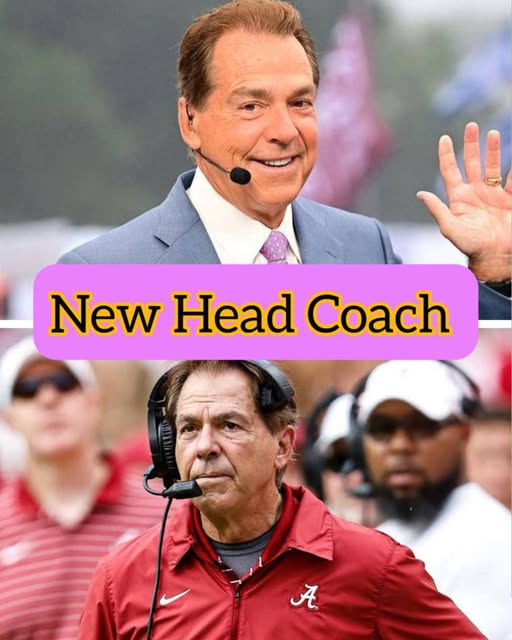The air is electric in Tuscaloosa. Fans are pouring into the streets in celebration, alumni are making last-minute travel plans to be near campus, and current players are trying to grasp the significance of what just happened. The University of Alabama has shaken the college football world to its core with an announcement no one saw coming but everyone will remember: Nick Saban, the iconic and legendary former head coach of the Alabama Crimson Tide, is officially returning to the program—not as head coach, but in a senior coaching advisory role. After retiring from coaching in January 2024, Saban’s return signals a new chapter not only in his unparalleled career but in the history of Alabama football.
For years, the words “Alabama” and “Saban” were practically interchangeable in the college football lexicon. Over 17 seasons, he built a dynasty unlike any other, guiding the Crimson Tide to six national championships and transforming the program into a relentless, finely tuned machine of success, discipline, and excellence. His departure left a vacuum, not just at Alabama but in the broader world of college football. Fans speculated about what would come next for him: television analyst, book author, perhaps even political aspirations. But few predicted this—his strategic re-entry into the Alabama football sphere as a guiding force behind the scenes.
The announcement came early Friday morning via a statement from the University of Alabama Athletic Department. The brief yet seismic press release read: “The University of Alabama proudly welcomes Coach Nick Saban back to our football family. Coach Saban will serve as Senior Coaching Advisor to the Crimson Tide, offering strategic oversight and leadership support to our current coaching staff and student-athletes.” Just like that, the floodgates of emotion, speculation, and celebration burst open.
Inside Alabama’s football facility, the news was met with a mix of awe and inspiration. For many of the young athletes currently on the roster, Saban has been a mythic figure—someone they grew up watching, a coach whose voice and stare alone could motivate players to give their all. Though most of them never played under him directly, his shadow has never truly left the building. Now, with his official return, players and coaches alike are grappling with the realization that they will have access to one of the greatest minds the sport has ever seen.
While the exact details of Saban’s role remain under wraps, insiders suggest his influence will be wide-reaching. Sources close to the program indicate that Saban will advise on everything from player development and defensive strategy to recruitment philosophy and leadership structure. He will not be micromanaging daily practices or calling plays on game day, but his presence is expected to elevate the program’s culture and direction in a way that no one else possibly could.
This move is not only a boon for Alabama football—it’s a masterstroke of timing and symbolism. Since Saban’s retirement, the Crimson Tide has experienced moments of uncertainty and vulnerability. While his successor has done admirable work to keep the program afloat, Alabama has not been the same juggernaut it once was. By bringing back the man who built the empire, the university is signaling that it intends to reclaim its throne at the top of college football.
And for Saban, this role offers the perfect blend of influence and flexibility. At 73, he no longer needs the grind of daily practices or the emotional toll of press conferences after every game. Yet his passion for football and mentorship clearly remains undiminished. Returning as a senior advisor allows him to contribute meaningfully without the relentless pressures of head coaching. It’s the ultimate win-win scenario—for him, for Alabama, and for college football at large.
The reaction from the Alabama faithful has been nothing short of euphoric. Bryant-Denny Stadium became an unofficial rally point within hours of the announcement, with fans donning crimson and white, waving flags, and chanting Saban’s name. Social media exploded with videos of celebrations across Tuscaloosa, tributes from former players, and speculation from pundits. One viral post summed up the moment perfectly: “The GOAT is back. Order has been restored in college football.”
Beyond the emotional response, there’s also a pragmatic side to this decision. Having Saban involved—especially during the recruiting cycle—is an undeniable asset. His mere presence in a meeting or phone call with a top recruit could sway decisions and bolster confidence in the program’s direction. Recruits will know that while they won’t be coached by Saban in the traditional sense, his fingerprints will be on every facet of the team they’re joining.
For the current coaching staff, led by Saban’s handpicked successor, this development is both a challenge and a blessing. Having the living legend return could be intimidating, but it also provides an unparalleled opportunity for growth. Young coaches can learn directly from the master, absorb his methodology, and enhance their own leadership skills under his mentorship. Saban has always emphasized the importance of “the process”—a system of preparation, execution, and discipline. Now, that process lives on in a new form, continuing to shape the next generation of Alabama leaders from within.
Former players have also chimed in with praise and excitement. Heisman winner Bryce Young tweeted, “Coach Saban back with the Tide? That’s championship energy right there.” Derrick Henry posted a photo of himself with Saban, captioned, “The General returns. Let’s get it.” The endorsement from legends who owe their careers to Saban’s system underscores how deeply his influence continues to run, even in his semi-retirement.
Nationally, this move has already begun to shift the college football landscape. Rival programs now face the prospect of competing with a rejuvenated Alabama—one that has its greatest asset back in the fold. Analysts are quickly revising their predictions for the season ahead, with Alabama once again emerging as a favorite to dominate the SEC and make a serious playoff run. ESPN’s Kirk Herbstreit commented, “This is a chess move of the highest order. While other programs zig, Alabama just zagged with the ultimate power play.”
And what about Saban himself? In a rare public appearance following the announcement, he offered a few words outside his Tuscaloosa home. “I’ve always said Alabama is home,” he stated. “I’ve spent the best years of my professional life here, and I still believe in what we’ve built. I’m not here to take over, I’m here to help however I can. This team means everything to me, and I’m proud to be back in a position to support their success.”
That humility and clarity of purpose are vintage Saban. He’s not returning for attention or glory; he’s returning because he loves the game, the school, and the standard he helped create. His willingness to step into a support role rather than the spotlight speaks volumes about his character and long-term vision for the program.
For the University of Alabama, this is more than a personnel move—it’s a reawakening of spirit, a restoration of identity, and a declaration of intent. The Crimson Tide is not content with past glories. It seeks more. It expects more. And with Nick Saban back in the fold, those expectations just got a lot more realistic.
As the sun sets over Tuscaloosa tonight, a new day begins in Alabama football history. The stadium may be quiet now, but the echoes of cheers, the renewed optimism, and the sense of destiny will carry through the coming weeks and months. The coach who once led the Crimson Tide to unimaginable heights has returned—not to rewrite the past, but to help shape the future. And in doing so, Nick Saban has once again reminded the world that legends may retire, but greatness never leaves.



